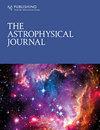太阳耀斑的准周期脉动与环振荡无关吗?
IF 5.4
2区 物理与天体物理
Q1 ASTRONOMY & ASTROPHYSICS
引用次数: 0
摘要
摘要研究了M8.7太阳耀斑(SOL2014-10-22)的振荡现象,包括光曲线上的准周期脉动和耀斑环路上的多普勒频移振荡。利用基于贝叶斯的马尔可夫链蒙特卡罗、快速傅立叶变换和小波分析方法,在脉冲相位的微波和硬x射线波段识别出QPPs,优势周期为40 ~ 50 s。它们应该与一个重复的能量释放过程相关联,该过程周期性地加速非热电子。另一方面,由于光谱观测的时间分辨率较低,我们不能排除外部波调制的可能性。然而,几乎在QPPs之后,少数耀斑环显示出其多普勒速度振荡,其显著周期为~ 4分钟,这是由日冕线Fe xxi 1354.08 Å (T ~ 10.7 K)的界面区域成像光谱仪观测到的,而其强度和宽度没有显示出类似的振荡。我们的观测表明,耀斑环振荡很可能是相位速度为~ 840 km s−1的快速扭结模式波。通过日冕地震学估计耀斑环的磁场强度为54 ~ 69 G。在这种情况下,QPPs和环振荡可以相互独立。本文章由计算机程序翻译,如有差异,请以英文原文为准。
Are Quasi-periodic Pulsations Independent of Loop Oscillations in Solar Flare?
Abstract We investigated oscillations in an M8.7 solar flare (SOL2014-10-22), including quasi-periodic pulsations (QPPs) in light curves and Doppler shift oscillations in the flare loops. Using Bayesian-based Markov Chain Monte Carlo, Fast Fourier Transform, and wavelet analysis method, QPPs were identified at microwave and hard X-ray wave bands during the impulsive phase, and the dominant period is 40–50 s. They should be associated with a repetitive energy release process, which accelerates nonthermal electrons periodically. On the other hand, we cannot rule out the possibility of the modulation of external waves because of the lower temporal resolution of spectroscopic observation. However, almost immediately after QPPs, a minority of flare loops display their Doppler velocity oscillations with a significant period of ∼4 minutes, which are observed by the Interface Region Imaging Spectrograph at the coronal line Fe xxi 1354.08 Å ( T ∼ 10 7 K), while its intensity and width show no similar oscillation. Our observations suggest that flare loop oscillations are most likely the fast kink mode waves with a phase speed of ∼840 km s −1 . The magnetic field strength in flare loops was estimated to be 54–69 G via the coronal seismology. The QPPs and loop oscillation could be independent of each other in this event.
求助全文
通过发布文献求助,成功后即可免费获取论文全文。
去求助
来源期刊

Astrophysical Journal
地学天文-天文与天体物理
CiteScore
8.40
自引率
30.60%
发文量
2854
审稿时长
1 months
期刊介绍:
The Astrophysical Journal is the foremost research journal in the world devoted to recent developments, discoveries, and theories in astronomy and astrophysics.
 求助内容:
求助内容: 应助结果提醒方式:
应助结果提醒方式:


